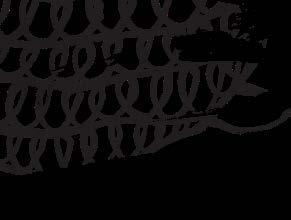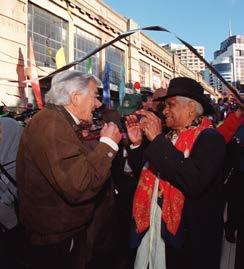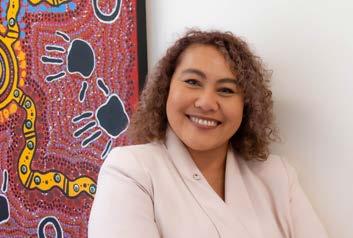
5 minute read
Let the young voices be heard
Marlee Silva is a 24-year-old Gamilaroi/Dunghutti writer, podcast host and Co-Founder of Tiddas 4 Tiddas, the social media-based movement dedicated to elevating stories of inspiring Aboriginal and Torres Strait Islander women and girls from across the country.
Marlee Silver

So you’re in your 20s or younger, you’re a blackfulla with a hunger to give back. More than anything, you’re determined to work for and with your people and nothing can get in your way.

But it gets a bit lonely in this fight and you know there’s strength in numbers, so you start looking to connect with and be supported by others just like you. Next thing you know, the universe – or your boss – answers your cries for connection and hands you an invitation to a conference; an Indigenous youth conference.
Deadly, right? What’s better than being in a room full of people just like you? Just as passionate about making a change, just as energetic and creative and rearing to go, and better yet, they really understand where you’re coming from. They know what you’ve been through in this day and age because they’ve grown up in the same era as you and experienced the same things.
When you get there, it’s all you could’ve hoped for. You swap yarns with your fellow ‘emerging leaders’ and are in awe of the similarities in your stories – it’s like you’ve known each other for years, not hours. Then you’re diving deep into discussions about solutions to some of our most complex issues, you workshop strategies, make huge plans inspired by the glossy array of guest speakers and thought-provoking panels, and as the event flies by, nearing its end, you feel pretty confident that you’re going to leave it and quite possibly, change the world.

As you’re packing up to head home, you realise there’s others who are just arriving. They’re a bit older and the event staff have swapped out the rolls of sticker name tags and butchers’ paper for “welcome drinks” and “goodie bags”.
This of course, is the general conference you weren’t invited too. You’ll find in media coverage from the following days, whilst you and your new youth mates have started a Facebook group to continue building your ideas, the other conference members will close their event with joint policy proposals and ideas spoken directly to attending government ministers or the like.
It’ll be a few more years before you get the same chance, and when you finally break into the big boys’ and girls’ auditorium, the irony will be in the guiding theme of the event: ‘The Next Generation: working with Aboriginal and Torres Strait Islander young people from 0-29’.
Recently, I presented at a youth conference on Larrakia country in Darwin. I spent the day with a room full of emerging Aboriginal and Torres Strait Islander leaders, who are driving change on the ground with their mob in the areas of education, health and healing through culture.
It was an event not unlike many others I’ve been asked to contribute to, as a now 24-year-old Gamilaroi and Dunghutti woman and the founder of Indigenous female empowerment initiative Tiddas 4 Tiddas.
It became immediately apparent that the attendees were undeniably impressive, inspiring, enthusiastic and hardworking people who just happened to be under the age of 30.
I’ve been on several ‘young people’, ‘looking to the future’ or ‘next generation’ panels and events in the past few years, and no matter the context, whether they’re Aboriginal-specific or not, the flaw in each of them is relatively the same. For one hour of the day, late in the afternoon, after hours of other experts mentioning stats about youth and what they think youth need to do, one to four young representatives will emerge on stage.
The crowd will ‘ooh’ or ‘aah’, watching us – young people with voices, opinions and expertise – like we’re unicorns. As we, the youth, stare back into the crowd, it will be obvious that we are in the minority. The fact is, over half of all Indigenous Australians fall into the youth category, and yet so few of us – who are praised for being in touch with the needs and attitudes of our peers on the ground, for taking initiative and building our own solutions to the areas we care most about and have lived experience in – are welcomed to the main stage of our national gatherings.
At this event in Darwin, the overwhelming sentiment from my peers was, why are we being treated like an afterthought? Why are the young ones crammed into a single day, away from the sight of the older, more experienced and more powerful attendees? Why does our youthfulness seem to devalue us in the eyes of leadership, and why is a seat at the decision and policy-making table something that feels so out of reach?
Youth suicide, out-of-home care and juvenile detention are three of the major areas that we, the young blackfullas, are exorbitantly overrepresented in, and while we are constantly surveyed and researched in this area, it seems such a missed opportunity to not have us included in the development of the solutions to it too.
Our older people are the epitome of our expertise and knowledge holders, there’s no denying that. But how can that be passed on if we’re not in the room to receive it? We’ve been battling with a lot of the same stuff for decades and we, the babies of the group, are starting to wonder if maybe we need to try things a bit differently.
So consider this, before you plan your next conference, when you’re thinking about how ‘cool’ and ‘fun’ it would be to set up a separate, off-site youth event, instead figure out ways to get young people, the true experts in youth, in the room. Embed opportunities for them to share their perspectives in safe and supported ways, and help us grow to our full potential, alongside you, as we step into the leadership roles of tomorrow.
Marlee’s debut novel ‘ My Tidda, My Sister’ inspired by Tiddas 4 Tiddas is due to be released in September 2020.

Marlee’s article first appeared in The Guardian in November 2019 through its partnership with IndigenousX showcasing the diversity of Indigenous peoples and opinions. We thank The Guardian and IndigenousX for permission to reproduce it.










